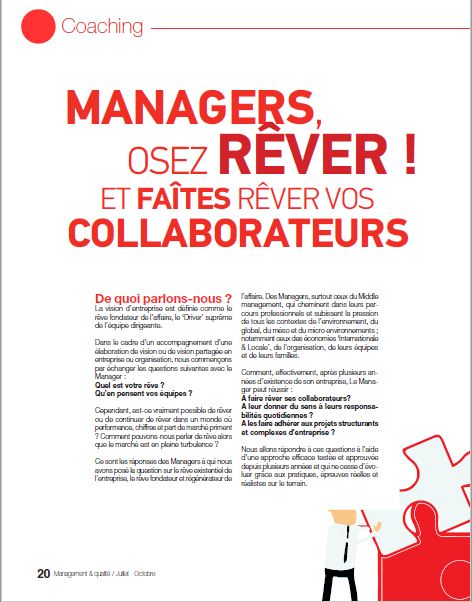What are we really talking about when we speak ofvision in business?
A company’s vision is its foundational dream—thedeep purpose that drives leadership and shapes its trajectory. It’s thestrategic anchor for decision-making, innovation, and inspiration.
In coaching sessions focused on vision setting orshared vision alignment, I always begin by asking managers two core questions:
- What is your dream?
- What do your teams think about it?
But here’s the catch: Is it still possible to dreamin a world ruled by performance metrics, numbers, and market share? Can leadersstill inspire when uncertainty dominates the landscape?
For many managers, especially those in middlemanagement, the answer lies in how they navigate internal and externalpressures—global markets, organizational complexity, team dynamics, and evenpersonal responsibilities.
✨ How Can Managers Keep the Dream Alive?
After years of running a business or leading teams,how can a manager:
- Inspire their teams to believe in something bigger?
- Give deeper meaning to daily responsibilities?
- Generate buy-in for complex organizational projects?
The answer lies in a proven and evolving method:
➤ Visionning: The Art of Sharing the Vision
“Leaders don’t force people to follow—they invitethem on a journey.”
—Charles S. Lauer
Let’s embark on that journey together.
🧭 What Is Visionning?
Visionning is a leadership concept introduced byMichael Doyle in 1994 and later enriched by other organizational coaches andresearchers. While books and articles abound, the real key lies in operationaldeployment—how a vision is embedded in culture, values, and managerialbehaviors.
Managers who adopt this mindset become VisionManagers, capable of leading with what I call the Sharing Attitude—thecornerstone of collective intelligence and change management.
🤝 The 4 Pillars of the Sharing Attitude
- Share the will – Communicate the company’s mission and vision clearly.
- Share the knowledge – Train and inform your teams consistently.
- Share the power – Empower your people, encourage autonomy.
- Share the gains – Involve employees through equity plans, bonuses, or profit-sharing.
Unlike rigid, traditional planning from the 1970s,visionning embraces the human element. It incorporates modern practices inorganizational coaching and agile leadership by co-constructing the"how" of success—with and through the people.
🧠 Visionning in Action: A Practical Process
At Coachinglab, we guide organizations through a3-step visionning journey. But first, let’s clarify a few key terms:
- Mission: Why the organization exists—its core reason for being.
- Vision: A future-oriented, desirable state—what the founder or shareholders dream of becoming.
- Ambition: The company’s long-term challenge (5–10 years), expressed in market share, impact, or influence.
- Values: What the organization stands for—how it aims to achieve its goals.
- Objectives: SMART goals (Specific, Measurable, Achievable, Realistic, Time-bound).
🛠️ The 3 Phases of Visionning
1. Current State – The Starting Point
Often the toughest step. It acts as an“icebreaker,” where leadership aligns on shared language and vision. Werecommend involving a seasoned coach to navigate ego dynamics and ensureconsensus on the fundamentals.
2. Diagnostic – SWOT Analysis
Teams work collaboratively to assess both theorganization and its environment, building a unified understanding of currentchallenges and opportunities.
3. Future Projections – Strategic Planning
Each business unit defines its own action plan,supported by KPIs (Key Performance Indicators) to track progress towardachieving the dream.
🌱 The Value of Visionning
A successful visionning process delivers:
- 🔗 Stronger team cohesion built on shared meaning and values
- 🗣️ Improved communication across all departments
- 🙌 Recognition of individual contributions
- 💡 Innovation spaces for collective creativity and ownership
- 🚀 Increased autonomy and performance across teams
Most importantly, this process does not end—itevolves continuously, just like your organization.
💡 Final Thought
Vision is not just a statement in the boardroom. Itmust live within the people who make it happen.
So, Managers: it's your time to dream!


